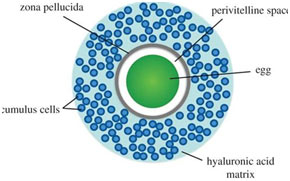Recognition and Gamete binding in Mammals
Recognition and gamete binding in mammals are done by going through the following steps.
Fertilizin and Anti fertilizin interactions
Elements that mediate sperm-egg interactions even before they make get in touch with, were recognized by F.R. Lillie (1912). He suggested the first theory of physiology of fertilization called fertilization theory.
He observed that the egg water (seawater surrounding unfertilized sea urchin eggs), agglutinated the sperm and triggered their motility. The response was species-specific. This element called fertilizin originated from the egg jelly coat.
It slowly dissolved as in seawater. Fertilizin was later shown to be the constituent of both jelly coat as well as egg membrane layer such as vitelline membrane layer as well as the plasma membrane.
Fertilizin is a proteoglycan. Both the amino acids as well as monosaccharides of fertilizin differ from one species to another to ensure that each species possesses its particular type of fertilizin.

The receptor sites for fertilizing exist on the sperm plasma membrane layer called anti fertilizin. These are acidic proteins. Attachment of spermatozoa to the surface area of the egg is produced by linking fertilizin molecules with anti- fertilizin molecules.
The response between fertilizin and anti-fertilizin resembles an antigen-antibody reaction. In both cases, a chemical lock is formed in between two free substances.
It has actually been suggested that the primary function of fertilizin—anti-fertilizin is to weaken the spermatozoa around the egg, to make sure that the chances of 2 or even more spermatozoa fusing with the egg at the same time are reduced.
a. Capacitation
In mammals, fertilization is internal. The reproductive tract plays a very important function in fertilization. The distinguished sperms are incapable to go through the acrosome reaction without residing for some time in the female reproductive system where they undergo physical modifications.
The change in the animal spermatozoan, which makes it with the ability to fertilize the egg, is called capacitation. There are four sets of molecular modifications, which take place throughout capacitation:
- Albumin proteins, present in the reproductive system, eliminate the cholesterol consequently modifying the fluidness of the sperm plasma membrane.
- Particular proteins or carbohydrates on the sperm surface area are lost during capacitation.
- Membrane capacity of the sperm comes to be more negative, as potassium ions leave the sperm.
This change in membrane potential opens up the calcium channels and also enables calcium to go into the sperm promoting the procedure of membrane combination throughout the acrosomal reaction.
- Protein phosphorylation takes place.
However, it not known whether these occasions are independent of one another as well as to what extent each one of them causes sperm capacitation.
b. Gamete binding
The mammalian egg is bordered by an extracellular envelope called zona pellucida. Around zona pellucid is a layer of cumulus cells (corona radiate) ingrained in a sealing substance, hyaluronic acid.
Hyaluronidase activity on the surface of the sperm head aids it to penetrate this layer. Next, sperm needs to bind to zona pellucida prior to they reach the surface area of the egg itself. The zona pellucida in animals plays a role similar to that of the vitelline envelope in lower vertebrates and invertebrates.
c. Acrosome reaction in mammals
Binding of the spermatozoan causes the acrosome reaction, which enables the sperm to penetrate the zona. Acrosome response in mammals involves the combination of the external membrane of the acrosome with the sperm plasma membrane layer.

After the fusion, the acrosomal membrane vesiculates which causes the release of acrosomal materials. Ultimately, the external section of the acrosomal membrane layer vanishes and only the inner portion adjacent to the core remains intact.
When the acrosomal materials are exocytosed, numerous enzymes are released. These enzymes allow the sperm to approach the egg plasma membrane. The mammalian acrosome reaction differs from that of sea urchin in that no acrosomal process is produced.
